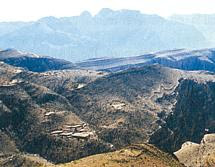Jabal Mahama (1042m), Wadi Khasab, Musandam, Oman.
 View south from Jabal Harem (ca. 2100m, also known as Jabal as Sayh). The highest summit on the Musandam Peninsula, Oman.
View south from Jabal Harem (ca. 2100m, also known as Jabal as Sayh). The highest summit on the Musandam Peninsula, Oman.
 On the ridge of Ra's Awlad (ca. 300m), Wadi Khasab, Musandam, Oman.
On the ridge of Ra's Awlad (ca. 300m), Wadi Khasab, Musandam, Oman.
 View south from Jabal Harem (ca. 2100m, also known as Jabal as Sayh). The highest summit on the Musandam Peninsula, Oman.
View south from Jabal Harem (ca. 2100m, also known as Jabal as Sayh). The highest summit on the Musandam Peninsula, Oman.
 Full moon over Khor Najd, evening, near Khasab, Musandam Fijords, Oman, Arabian Peninsula
Full moon over Khor Najd, evening, near Khasab, Musandam Fijords, Oman, Arabian Peninsula

 View south from Jabal Harem (ca. 2100m, also known as Jabal as Sayh). The highest summit on the Musandam Peninsula, Oman.
View south from Jabal Harem (ca. 2100m, also known as Jabal as Sayh). The highest summit on the Musandam Peninsula, Oman.  On the ridge of Ra's Awlad (ca. 300m), Wadi Khasab, Musandam, Oman.
On the ridge of Ra's Awlad (ca. 300m), Wadi Khasab, Musandam, Oman.  View south from Jabal Harem (ca. 2100m, also known as Jabal as Sayh). The highest summit on the Musandam Peninsula, Oman.
View south from Jabal Harem (ca. 2100m, also known as Jabal as Sayh). The highest summit on the Musandam Peninsula, Oman.  Full moon over Khor Najd, evening, near Khasab, Musandam Fijords, Oman, Arabian Peninsula
Full moon over Khor Najd, evening, near Khasab, Musandam Fijords, Oman, Arabian Peninsula 





